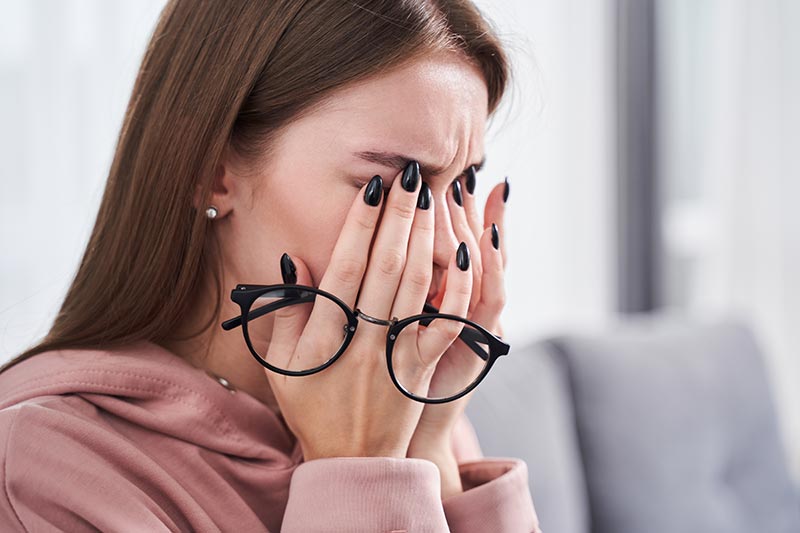Dry Eye

Diagnosis and Treatment for Dry Eye
Symptoms of dry eye are uncomfortable, but we can help! The doctors at Nova Vision Center have the expertise to diagnose and treat dry eye leading to good outcomes for patients.
What is Dry Eye?
Dry eye is a chronic condition where the person doesn’t produce enough quality tears to lubricate and nourish the eyes. Tears help give you clear vision, lubricate your eyes, protect against infection, and help with wound healing, so the proper production and drainage of tears is an important part of maintaining optimal eye health and vision.
Because dry eye is a common condition where the symptoms can mimic those of other issues like eye allergies, it is frequently under-diagnosed.
What Causes Dry Eye?
People can develop dry eye for many different reasons.
People over the age of 65 can develop dry eye due to the aging process. Women are more likely to develop dry eyes due to hormonal changes caused by pregnancy, the use of oral contraceptives and menopause. Use of antihistamines, decongestants, blood pressure medications and antidepressants can reduce the production of tears and cause symptoms of dry eye. People with certain conditions, such as rheumatoid arthritis, diabetes, or thyroid problems, are more likely to experience dry eye symptoms. Inflammation of the eyelids and inflammation of the surfaces of the eye can cause dry eye. Exposure to cold, smoke, and dry climates can lead to tear evaporation, which in turn leads to dry eye symptoms. Failure of the eyes to blink frequently (during long periods of computer use for example) may also cause symptoms of dry eye.
One of the most common reasons for chronic dry eye is meibomian gland dysfunction (MGD). The meibomian glands are small oil glands located in the eyelids and secrete oil which coats the surface of the eyes and prevents moisture from evaporating. Water and the oil layer are what make up the tear film, and this tear film is what keeps the surface of the eye healthy. Meibomian gland dysfunction (MGD) occurs when the oil-producing meibomian glands are clogged and unable to create a healthy tear film to keep the eyes properly lubricated.
What are Symptoms of Dry Eye?
If you are experiencing the following symptoms, you may have dry eye syndrome:
- Burning, stinging, or itching eyes
- A scratchy or sandy feeling in your eyes
- Increased sensitivity to light
- Eye pain or redness
- Stringy mucus or discharge from your eyes
- Fluctuating vision
Symptoms may be made worse by activities like driving, reading, computer use, or watching TV, as you blink less often at these times. When your eyes are not properly lubricated, they are more likely to dry out and become irritated.
Treatment for Dry Eye
Our qualified eye doctors are trained in diagnosing and treating dry eye syndrome. Through the evaluation and tests performed at a comprehensive eye exam, your optometrist will gather the information needed to determine if you have dry eye. If a diagnosis is made, your doctor will work with you to put a treatment plan in place tailored to your unique vision and ocular health needs.
Dry eye syndrome can vary in severity from person to person, so we provide customized treatment based on the needs of the individual. Nova Vision Center offers safe and effective treatment solutions for dry eye, including intense pulsed light (IPL) therapy treatments in our office.
Intense Pulsed Light (IPL) Therapy
Intense Pulsed Light (IPL) Therapy has been in use by dermatologists for decades to treat rosacea, but now, it’s also a revolutionary and highly effective treatment for chronic dry eye and meibomian gland dysfunction (MGD).
How Does IPL Therapy Work?
IPL therapy uses wavelengths of light to reduce inflammation and works on the root cause of most cases of chronic dry eye, meibomian gland dysfunction (MGD).
During IPL therapy, the heat generated by the wavelengths of light releases oils that have become hardened and have clogged the meibomian glands so that the blockages are removed which cause chronic dry eye symptoms and improves the quality of the tears.
Intense Pulsed Light (IPL) Therapy
We begin the therapy by placing shields over the eyes to protect them from the wavelengths of light. After placing the shields over the eyes, a cooling gel is applied to the treatment area and a small device painlessly administers the light to the area around the eyelids which will break up the clogged buildup.
After the wavelengths of light are administered, oil is expressed from the meibomian glands to restore the flow of oil in the tear film. Patients can experience an improvement in the symptoms of dry eye after the first IPL therapy treatment, but typically the recommended length of the therapy is to undergo monthly treatments for a four-month period.
After Intense Pulsed Light (IPL) Therapy
Patients may experience blurry vision for a few days after the treatment, and this shouldn’t be a concern as it means that the meibomian glands are producing more oil than the eyes are used to. Aside from some blurriness in the vision, there’s no reason for downtime, and patients can resume daily activities right away.
Diagnosis and Treatment for Dry Eye in Northern Virginia
If you think you may be experiencing dry eye, contact our office to schedule an eye exam with the optometrists at Nova Vision Center.
